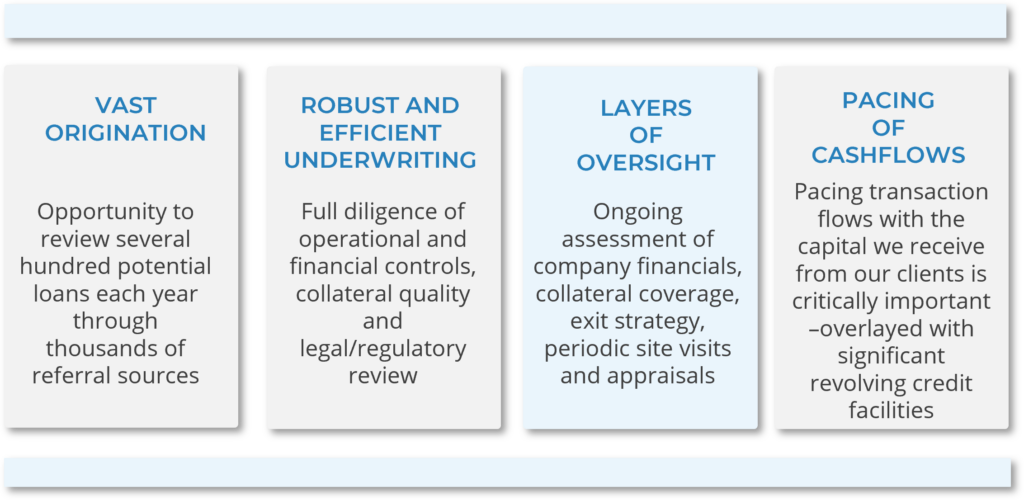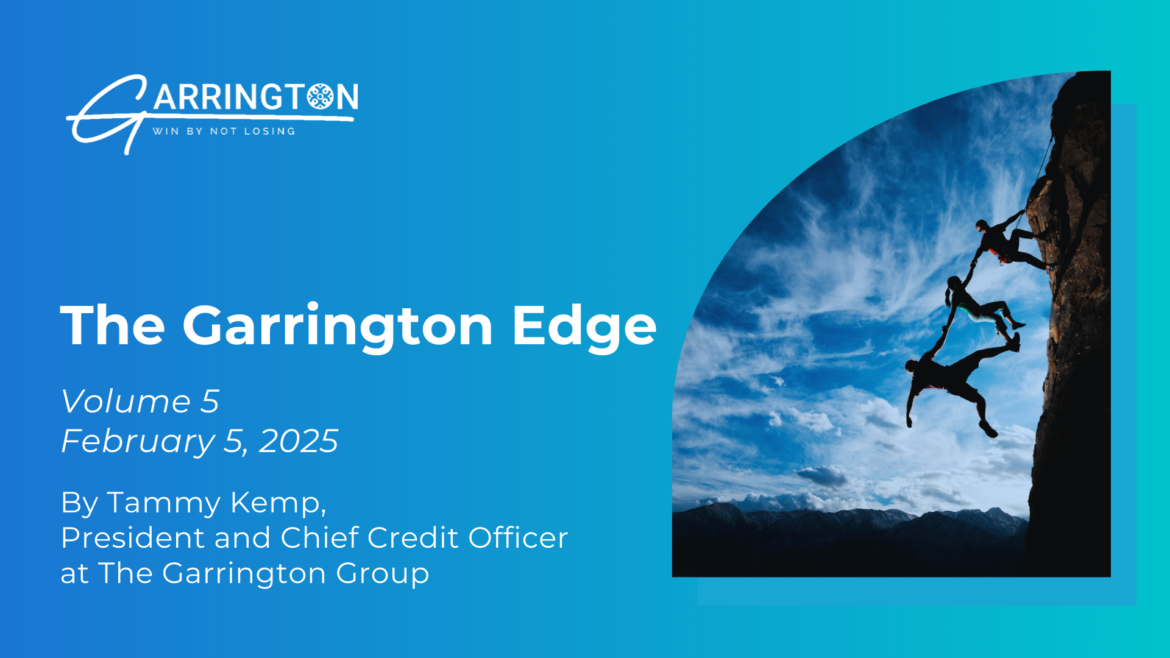The Third Pillar: Layers of Oversight
Following the difficult task of sourcing opportunities and the rigor of the underwriting process the work of managing risk through effective and efficient portfolio management begins.
It is not enough to thoughtfully choose opportunities and robustly scrutinize the collateral and business plan at the start of the relationship. There is as much (or more) work needed when a transaction closes as there is to get it approved.
Garrington Investment Philosophy – Garrington Four Pillars of Strength
Private lending to SME businesses in North America, primarily in loan sizes under USD $30 million can provide excellent risk adjusted returns relative to other asset classes WHEN MANAGED APPROPRIATELY

It is a challenging task to manage risk and client retention; this natural dichotomy is at the heart of portfolio management.
Establish the base line
Key for us is understanding how the financing accelerates our client’s business. Whether our client is recovering from a challenge or is growing by leaps and bounds, they will have a financial outlook, the map of where they are going and the role our financing will play in achieving these goals.
This financial plan forms the basis for our ongoing assessment of our client’s financial health, and measuring this plan against the actual results provides a basis for the Portfolio Management team to engage with our clients. Whether positive or challenged, these results are discussed and inform the manner in which the deal is managed.
Build trust

Every business has ebbs and flows. The key to managing the inherent risks is building a strong relationship with our clients. This begins in the underwriting process and continues throughout the life of the loan.
Lending is about people first. Understanding our clients’ businesses and challenges, learning and listening while building a strong foundation, is an invaluable tool in our toolbox to aid in uncovering potential pathways forward when there is a problem.
Seeing trends and identifying when the business is going off track is only part of managing risk. Knowing how to address the issue with our client is absolutely key. Our team has learned to be comfortable in the uncomfortable. Because our Portfolio Management team engages with our clients consistently, they build trust and can address issues or challenges early. Identifying and addressing problems early gives our client and the Portfolio Management team the advantage of time and options, which are essential for achieving positive outcomes.
Monitor Trends and Collateral Values
When paired with projections, financial results tell only part of the story.
Most of our clients require funding weekly. We see how our collateral performs consistently over short and longer intervals.
Our portfolio management software systems ingest funding data on a daily and weekly basis. This consistent trend data provides significant insight into collateral performance; from how quickly inventory turns into receivables to how quickly customers pay invoices to changes in the quality of the products or services. Understanding this level of collateral performance is an integral piece of risk management. Small changes emerging over several weeks will give rise to smart questions and discussions early when problems are smaller and more manageable.
Regularly updated inventory and equipment appraisals by professionals are an essential tool in the risk mitigation toolbox as a wellness check to understanding collateral recovery values.
Collateral values change over time. For example:
- The composition of a client’s inventory has an impact on its value; changes in slow-moving inventory components due to manufacturing overruns can build up over time. Understanding these sometimes-subtle changes should impact lending values as they will impact recovery values.
- Equipment appraisals and inspections are an essential window into a business. A well-maintained fleet of equipment indicates pride in ownership and higher recovery values. Similarly, it can be an early warning sign of cash flow issues if the equipment is poorly maintained or if parts are being cannibalized from out-of-service assets to maintain other assets, all a sign of deterioration in collateral values that will impact recoveries. It is critical to address these challenges head-on.
In addition, field examiners provide periodic updates on the business fundamentals; another tool in our arsenal. They can verify and validate the data supplied weekly in support of funding. This independent third-party review from a different perspective can highlight areas of stress or areas that may require greater attention. A second set of eyes is always welcome, even if only to confirm what the Portfolio Management team already sees.
Consistent meetings at the client’s business, whether by appraisers, field examiners, or Portfolio Management team members, are vital methods of identifying issues early and managing risk.
Risk Management is a People Business
Simply, there is no replacement for old-fashioned human intuition when managing risk. “Trust but verify” is a motto that is embedded in everything we do.
All the best-documented procedures and processes are meaningless unless the people tasked with the work care about what they do and how they do it. Engaged and empowered people who understand and appreciate the purpose of the documented policies and the value of following the procedures are the power behind excellent portfolio performance.
Strong teams use processes to help identify issues. Employing strong customer relationships, thoughtful use of professional third parties, and vigilant identification of changing trends are the tools of our trade, and when expertly employed, they are the best form of risk mitigation.
Conclusion
Selling money is easy; getting it back takes commitment, dedication, and vigilance. Proper oversight doesn’t follow a narrow path, and success doesn’t come from a one-size-fits-all approach.
Successful portfolio management is a multi-layered art informed by experience, continuous learning, active listening, and employing thoughtful processes performed by engaged and empowered team members.




April Fund Commentary